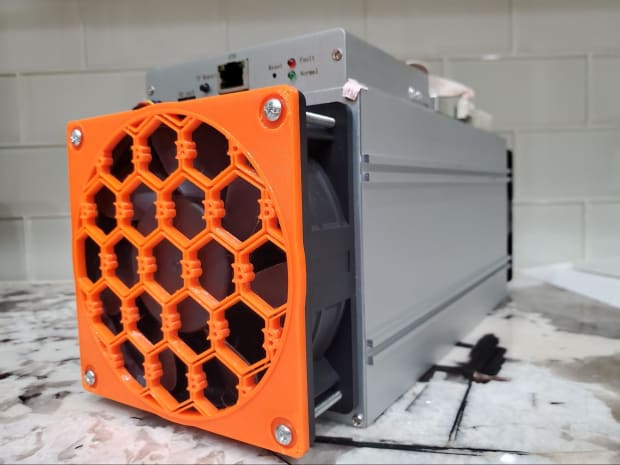Local meetups are implementing bitcoin mining lending programs to give members a chance to try home mining and learn about the Bitcoin network.
This is an opinion editorial by Barnminer, a Bitcoiner focused on improving self-sovereignty, on-boarding home miners, and a contributor at Bitcoin Magazine.
Having access to a borrowed ASIC for a day, week or month, will provide enough learning for the ins-and-outs of home mining, including some basic challenges. This allows a low-risk entry into participating in the backbone of the Bitcoin network. One will learn about set up, sound mitigation, heat, electricity and home networking. An Antminer S9 can operate underclocked on a 120-volt circuit. After the experience, one can make a longer-term decision about pursuing mining bitcoin in their home.
- Is it too much work or do I want to move forward with mining?
- Do I need to mitigate noise and/or heat?
- Does it make sense to mine bitcoin at home in the long run, given my electricity rate ?
Even if one decides mining bitcoin is not their thing, they have learned a great deal about the Bitcoin network.
I started an Antminer S9 loaner program with my local Bitcoin meetup group. The idea came from a good friend who gets credit for the concept. Someone donated the Antminer S9 for this program, which was inspired by a Twitter conversation. I wanted to share this program with others in the hope that we can reproduce this program across the globe.
I would not be where I am at this point without the help of other Bitcoiners taking time out of their day to teach me. For this, I am thankful. Creating a local S9 loaner program is a good way to give back. It has enhanced my own education by teaching others. The program provides an opportunity to take a quick dive into proof of work. You learn how to deal with the three main hurdles relating to at-home mining: electricity, heat and sound. Additionally, you obtain a better understanding of how mining pools operate and how miners are rewarded for their hash rate.
The program is simple. The goal is to teach people about the proof-of-work consensus mechanism and learn the basics of at-home mining. This provides an opportunity for local Bitcoiners to try their hand at mining with no ASIC capital outlay. A used S9 can cost $500. Further, people run the risk of being scammed if they don’t know how to navigate the difficulties of acquiring a used piece of equipment. I have heard stories of scams or buyers receiving defective hardware. Renting one out from a trusted pleb is a safe way to get your hands on hardware with local support.
If the intended user has an available 240-volt circuit in the garage, setup costs can be minimal. Additionally, the Antminer S9 can be run on 120 volts if properly underclocked. If you have a 240-volt dryer receptacle, you are halfway there. If not, the cost to have an electrician wire up circuit in a garage is between $125 and $175. The person borrowing the miner has to understand that this is an educational experience. It is not a money-making opportunity. In my local service area, the residential electric rate operating an Antminer S9 is break-even — at best. It is an opportunity to plug in an ASIC, connect it to a pool and let it go “brrrr.” There is a lot to be said about learning by getting your hands dirty.
The first taker in the loaner program had an available dryer receptacle. Their cost to swap the receptacle was minimal because they happened to have a relative who was an electrician. Needless to say this was the perfect first-taker. The time frame for the program can be one to three months or more. This is enough time to get an idea of how the process comes together and to overcome any obstacles one may encounter. With my borrower, I did not set a time frame. I wanted it to be an opportunity for them to dip their toes in the pool (pun intended).
The next borrower will set up a two-of-three multisig wallet to pay a deposit on the miner. This process will show how simple it is to set up a multisig wallet and get them to start thinking about wallets, private keys and what can be built for their cold storage setup. This is not to make any money for the person leasing out the equipment, but to educate the participants and to give some protection against damage or theft.
It is recommended doing a two-of-three multisig with the borrower, lender and a trusted third-party holding one private key each. The third person could be the meetup host or a mutual friend in the space. The borrower would post some sats with the lender as collateral in case any issues arise, i.e., they disappear with the ASIC or they abuse the hardware. The third key-holder of the multisig wallet should be an active member in the group or an independent third party that may need to mitigate any disagreement that may arise.
If you run a Bitcoin meetup, consider creating a loaner program. Find a sponsor to donate or have the group pitch in together for the hardware.
In summary, an S9 loaner program will help spread knowledge of Bitcoin mining and multisig setup. Participants can learn more by doing than reading or watching. Give the gift of education and consider creating your own loaner program locally. The benefit of giving back to the community can be rewarding.
The latest Bitcoin meetup to introduce this program Is NWA Bitcoin. If you are in the Bentonville, Arkansas, area, consider going to an event. You may have the opportunity to get in line to borrow an S9. Let’s get hashing.
This is a guest post by Barnminer. Opinions expressed are entirely their own and do not necessarily reflect those of BTC Inc. or Bitcoin Magazine.





 BTC-USD
BTC-USD  ETH-USD
ETH-USD  LTC-USD
LTC-USD  XRP-USD
XRP-USD